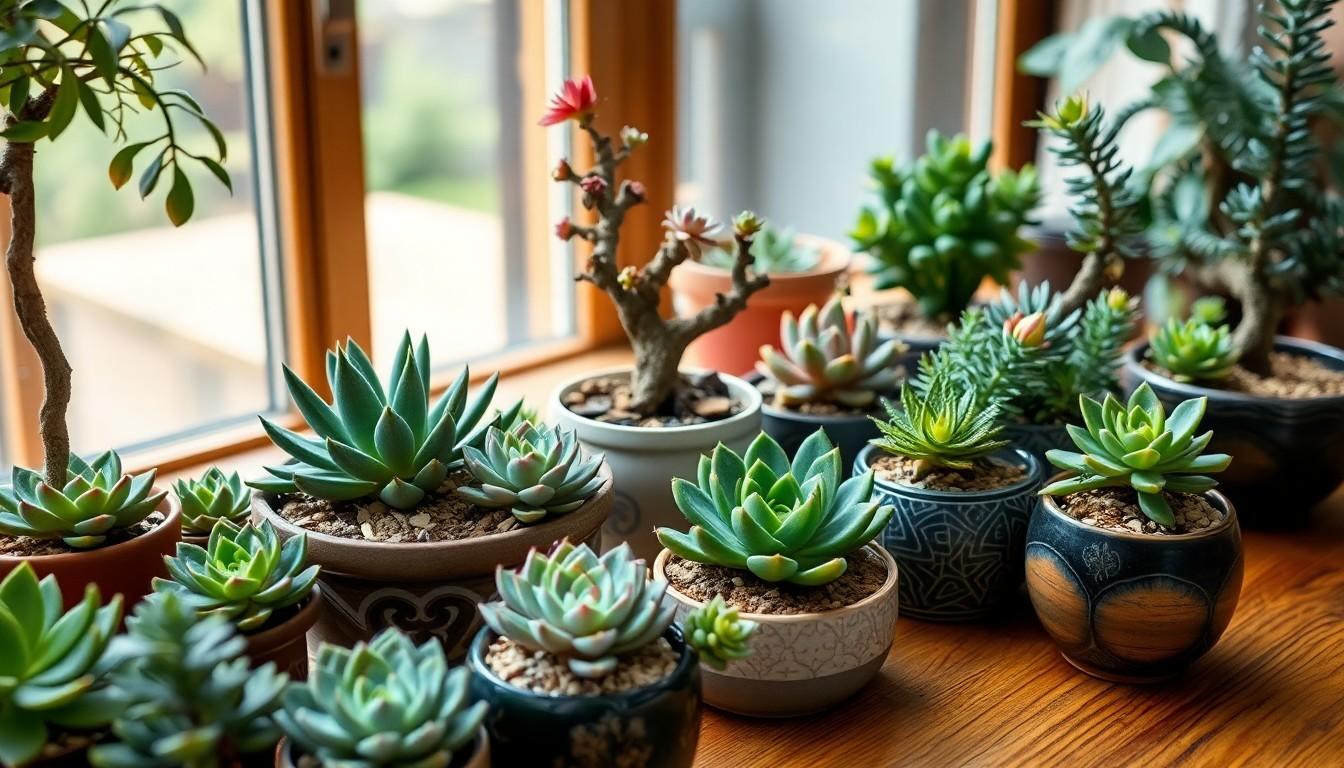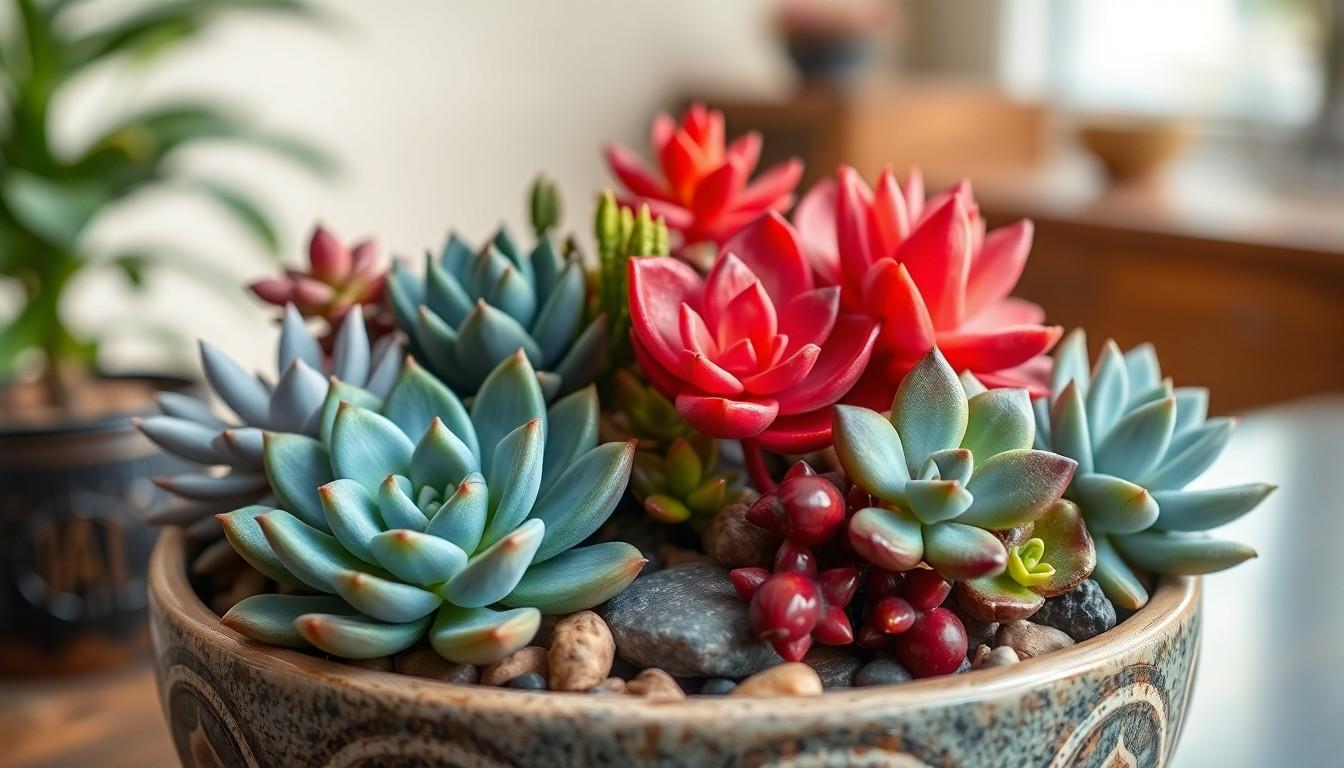Bonsai succulents are the perfect blend of artistry and low-maintenance charm. Imagine tiny trees that don’t just survive on neglect but thrive on it! These miniature marvels are great for those who want to bring a touch of zen to their space without the hassle of a full-blown garden.
With their quirky shapes and vibrant colors, bonsai succulents can turn any dull corner into a lively conversation starter. Plus, they’re like the introverts of the plant world—beautiful yet low-key, requiring minimal water and care. Who wouldn’t want a little green companion that’s as resilient as a cactus in a drought? Dive into the world of bonsai succulents and discover how these pint-sized plants can elevate your home decor while keeping your stress levels in check.
What Are Bonsai Succulents?
Bonsai succulents are compact, miniature plants that blend the art of bonsai cultivation with the hardiness of succulents. These plants typically exhibit thick, fleshy leaves that store water, allowing them to survive in arid conditions. Cultivators often shape them through pruning and wiring, creating unique forms that showcase their beauty.
Most bonsai succulents feature vivid colors and interesting textures, enhancing their aesthetic appeal. Popular varieties include jade plants, echeverias, and haworthias. These specific plants thrive in bright, indirect sunlight, making them suitable for indoor environments.
Caring for bonsai succulents involves minimal watering, generally every two to four weeks, depending on environmental conditions. A well-draining soil mix promotes healthy growth by preventing root rot. Heavier watering can occur during the growing season, spring and summer, while less frequent watering takes place in the dormant months.
Bonsai succulents hold cultural significance in various traditions, representing patience and harmony. They serve as a symbol of resilience due to their ability to flourish despite harsh conditions. By incorporating these plants into home decor, individuals can connect with nature and enhance their surroundings.
Artistic expression often comes into play with bonsai succulents, as they can be styled in numerous ways. Designers use these plants to create living sculptures, merging nature with creativity. Overall, bonsai succulents are more than just decorative plants; they foster tranquility and invite mindfulness into daily life.
Types of Bonsai Succulents

Bonsai succulents encompass a variety of unique plants, each contributing distinct aesthetics and care requirements. Understanding these types enhances the overall enjoyment of bonsai cultivation.
Popular Varieties
Jade plants, echeverias, and haworthias stand out among popular bonsai succulent choices. Jade plants feature thick, oval-shaped leaves that symbolize good fortune. Echeverias showcase a rosette shape with vibrant colors, adding an appealing visual element. Haworthias, often marked by striking patterns and textures, offer uniqueness and resilience. Other notable varieties include lithops, known as living stones, which mimic their surrounding environment and are perfect for a natural look.
Unique Features
Bonsai succulents present several unique characteristics that set them apart from traditional bonsai trees. Compact growth forms enable them to fit into small spaces effortlessly, making them suitable for various indoor settings. Thick, fleshy leaves allow for water storage, which supports survival in arid environments. Their adaptability to pruning and training results in innovative shapes and styles, perfect for artistic expression. Additionally, vibrant colors enrich decor, offering a lively touch. Each variety emphasizes low-maintenance care, appealing to both seasoned bonsai enthusiasts and beginners alike.
Care Tips for Bonsai Succulents
Caring for bonsai succulents involves specific practices to ensure their health and longevity. Proper attention to watering and light makes a significant difference in their growth.
Watering Guidelines
Watering bonsai succulents requires careful consideration. Allow the soil to dry out between waterings, which prevents root rot. Usually, watering every two to four weeks suffices, with frequency influenced by the plant’s environment. Checking the moisture level can help determine when to water, as overwatering can be detrimental. During the growing season, increased warmth might call for more frequent watering, while cooler conditions necessitate less. Monitor the soil, ensuring it drains well after irrigation to maintain optimal health.
Light Requirements
Bonsai succulents thrive in bright, indirect sunlight. Positioning them near south or east-facing windows offers the best exposure. Intense direct sunlight can scorch the leaves, so filtered light is ideal. Optimal light duration typically spans six to eight hours each day. Adjust placement based on seasonal changes in sunlight intensity, as they may require varying light levels throughout the year. Providing proper light conditions encourages growth and vibrant colors, enhancing the plant’s aesthetic appeal while promoting overall health.
Designing Your Bonsai Succulent Arrangement
Creating a bonsai succulent arrangement combines artistry and nature’s beauty. Thoughtful design elevates both aesthetics and plant health.
Potting Options
Choosing the right pot is essential for bonsai succulents. Terracotta pots offer breathability, allowing soil to dry effectively. Alternatively, ceramic pots provide a splash of color and decor. Ensure drainage holes exist to prevent water accumulation. Lightweight options like plastic may appeal for easier handling and moving. Selecting a pot that complements the plant’s aesthetic enhances visual appeal. Sizes should match the plant’s growth, allowing enough space for roots.
Aesthetic Considerations
Aesthetics play a significant role in bonsai succulent arrangements. Grouping various succulent species creates visual interest, showcasing different colors and textures. Taller plants can serve as focal points, while shorter ones fill spaces around them. Consider layering by varying heights to add depth. Using decorative stones or driftwood can introduce an organic element to the display. Positioning arrangements in natural light emphasizes their vibrant hues, enhancing overall impact. Each choice contributes to a harmonious blend of nature and art.
Conclusion
Bonsai succulents offer a captivating blend of artistry and practicality. Their unique forms and vibrant colors not only beautify spaces but also promote a sense of calm. With minimal care requirements and resilience to neglect, these plants are perfect for anyone looking to enhance their environment without the stress of traditional gardening.
By thoughtfully arranging different varieties in well-draining pots, enthusiasts can create stunning displays that reflect personal style. Whether for a seasoned gardener or a beginner, bonsai succulents provide an inviting opportunity to connect with nature while enjoying the benefits of low-maintenance plant care. Embracing these miniature wonders can truly transform any space into a serene oasis.

